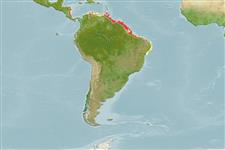Common names from other countries
Environment: milieu / climate zone / depth range / distribution range
Écologie
marin; saumâtre démersal; profondeur 1 - 36 m (Ref. 13608). Tropical; 16°N - 14°S, 87°W - 34°W
Western Central Atlantic: Honduras to Salvador (Bahia) in Brazil.
Length at first maturity / Taille / Poids / Âge
Maturity: Lm 20.0 range ? - ? cm
Max length : 57.0 cm TL mâle / non sexé; (Ref. 3273); common length : 35.0 cm TL mâle / non sexé; (Ref. 3273); poids max. publié: 2.3 kg (Ref. 5217)
Épines dorsales (Total) : 3; Rayons mous dorsaux (Total) : 28 - 30; Épines anales: 0; Rayons mous anaux: 25 - 27. Supraorbital and interorbital region smooth, without any filament; scaled area on head extending to middle of eye and opercle spine; 9 discrete pores on inner face of pectoral fin; body brown, with black spots and saddle-shaped blotches (Ref. 13608).
Mainly in brackish water (Ref. 5217). Found on sandy-muddy bottoms in shallow warm water. Not so active, lingers over the substrate disguised. Feeds on small gastropod mollusks, crustaceans like crabs (Calappidae, Portunidae, Xanthidae, etc.), shrimps (Penaeidae, Palaemonidae, Alphaeidae, etc.) and fishes. Females are mature at around 20 cm length, males at 25 cm. Spawns 400 to 500 eggs, with a size of 4 to 5 mm (Ref. 35237). Marketed fresh.
Life cycle and mating behavior
Maturities | Reproduction | Spawnings | Egg(s) | Fecundities | Larves
Collette, B.B., 1978. Batrachoididae. In W. Fischer (ed.) FAO species identification sheets for fishery purposes. West Atlantic (Fishing Area 31), Volume 1. FAO, Rome. (Ref. 3273)
Statut dans la liste rouge de l'IUCN (Ref. 130435)
CITES (Ref. 128078)
Not Evaluated
Menace pour l'homme
Harmless
Utilisations par l'homme
Pêcheries: commercial; Aquarium: Commercial
Outils
Articles particuliers
Télécharger en XML
Sources Internet
Estimates based on models
Preferred temperature (Ref.
115969): 27.1 - 28.3, mean 27.6 (based on 300 cells).
Phylogenetic diversity index (Ref.
82804): PD
50 = 0.5020 [Uniqueness, from 0.5 = low to 2.0 = high].
Bayesian length-weight: a=0.00776 (0.00485 - 0.01241), b=3.15 (3.01 - 3.29), in cm Total Length, based on LWR estimates for this species & (Sub)family-body (Ref.
93245).
Niveau trophique (Ref.
69278): 3.7 ±0.62 se; based on food items.
Résilience (Ref.
120179): Faible, temps minimum de doublement de population : 4,5 à 14 années (Preliminary K or Fecundity.).
Fishing Vulnerability (Ref.
59153): Moderate vulnerability (43 of 100).
